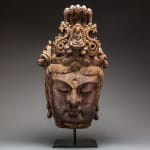Ming Dynasty Bodhisattva Head, 1368 CE - 1644 CE
Wood
50.2 x 29.2 cm
19 3/4 x 11 1/2 in
19 3/4 x 11 1/2 in
BF.001 (LSO)
Further images
This striking polychrome head of a Bodhisattva dates to the M’ing Dynasty, one of China’s most socially significant periods. It depicts a well-carved face with closed eyes and a reflective...
This striking polychrome head of a Bodhisattva dates to the M’ing Dynasty, one of China’s most socially significant periods. It depicts a well-carved face with closed eyes and a reflective expression, surmounted by hair piled up into a mound, and an astonishingly ornate crown made up of foliate scrollwork and an assortment of diadems. The face is very well rendered, with eyes that slant upwards towards the edges under high, arched brows that join the nose in a T-bar format. The cheeks are fleshy and rounded, with a pouchy arrangement that frames the base of the nose and the small pouted lips. The bindi (or kum kum, or baihao) mark on the forehead is rendered as a depression that was originally designed to hold an inlay, since lost. The ears are pendulous, long and pierced. The crown is exceptional. It is attached to a cone-shaped dome of hair, which is bound horizontally with ties. The crown elements are attached to a band that circles the head at its apex, supporting a large foliate scrollwork diadem that equals the height of the face, decorated with a small Buddha figure seated on a plinth, and a lotus flower deflected inferiorly. The central element is balanced by lateral sconces in the same general form.
The current piece represents a Bodhisattva – an enlightened being who chooses not to enter Nirvana, preferring to help others attain the necessary enlightenment to do so. Indeed, she is known to the West as the Goddess of Compassion. They are usually very ornate, and in this sense all the Bodhisattvas differ from representations of Buddhas, who eschew such worldly displays in favour of ascetic simplicity. Large sculptures such as the one of which this is a part were usually displayed in centralised temples, or in the homes of wealthy and presumably pious members of the M’ing social elites.
Established in 1368, the M’ing dynasty was founded by Hong Wu, one of only three peasants ever to rise to imperial pre-eminence. His attitudes towards rule reflected his own past, with considerable emphasis on agricultural production, an aversion to trade, a massive expansion of military power and spending a fortune on defences (notably the Great Wall). This philosophy, while partly reflexive, was based loosely upon Confucianism, with which China had had a love-hate relationship for much of the preceding millennium. Despite his prejudices, the inevitable effect of Hong Wu’s policies was stability, and with it the rise and rise of the middle classes. While in many respects a martially vigorous and ascetic time, the enormous wealth generated by agricultural surpluses led to an unexpected flowering of arts under the patronage of what was essentially the nouveau riche, who liked to surround themselves with artworks including lacquer work, paintings, prestige ceramics and sculptures both for this life and for the hereafter (mingqi). It is into the former category that the current piece falls.
This is a beautiful and ornate piece of M’ing Dynasty art.
The current piece represents a Bodhisattva – an enlightened being who chooses not to enter Nirvana, preferring to help others attain the necessary enlightenment to do so. Indeed, she is known to the West as the Goddess of Compassion. They are usually very ornate, and in this sense all the Bodhisattvas differ from representations of Buddhas, who eschew such worldly displays in favour of ascetic simplicity. Large sculptures such as the one of which this is a part were usually displayed in centralised temples, or in the homes of wealthy and presumably pious members of the M’ing social elites.
Established in 1368, the M’ing dynasty was founded by Hong Wu, one of only three peasants ever to rise to imperial pre-eminence. His attitudes towards rule reflected his own past, with considerable emphasis on agricultural production, an aversion to trade, a massive expansion of military power and spending a fortune on defences (notably the Great Wall). This philosophy, while partly reflexive, was based loosely upon Confucianism, with which China had had a love-hate relationship for much of the preceding millennium. Despite his prejudices, the inevitable effect of Hong Wu’s policies was stability, and with it the rise and rise of the middle classes. While in many respects a martially vigorous and ascetic time, the enormous wealth generated by agricultural surpluses led to an unexpected flowering of arts under the patronage of what was essentially the nouveau riche, who liked to surround themselves with artworks including lacquer work, paintings, prestige ceramics and sculptures both for this life and for the hereafter (mingqi). It is into the former category that the current piece falls.
This is a beautiful and ornate piece of M’ing Dynasty art.







